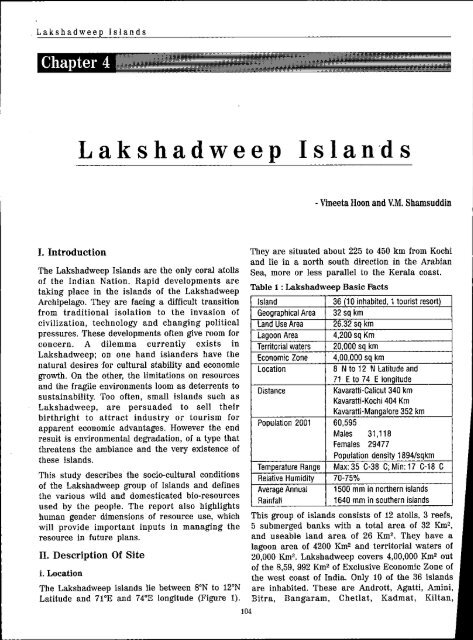06-bioresourcesstatu.. - M. S. Swaminathan Research Foundation
06-bioresourcesstatu.. - M. S. Swaminathan Research Foundation
06-bioresourcesstatu.. - M. S. Swaminathan Research Foundation
You also want an ePaper? Increase the reach of your titles
YUMPU automatically turns print PDFs into web optimized ePapers that Google loves.
. Lakshadweep Islands<br />
I. Introduction<br />
Lakshadweep lsI a nod s<br />
The Lakshadweep Islands are the only coral atolls<br />
of the Indian Nation. Rapid developments are<br />
taking place in the islands of the Lakshadweep<br />
Archipelago. They are facing a difficult transition<br />
from traditional isolation to the invasion of<br />
civilization, technology and changing political<br />
pressures. These developments often give room for<br />
concern. A dilemma currently exists in<br />
Lakshadweep; on one hand islanders have the<br />
natural desires for cultural stability and economic<br />
growtb. On the other, the limitations on resources<br />
and the fragile environments loom as deterrents to<br />
sustainability. Too often, small islands such as<br />
Lakshadweep, are persuaded to sell their<br />
birthright to attract industry or tourism for<br />
apparent economic advantages. However the end<br />
result is environmental degradation, of a type that<br />
threatens the ambiance and the very existence of<br />
these islands.<br />
This study describes the socio-cultural conditions<br />
of the Lakshadweep group of Islands and defines<br />
the various wild and domesticated bio-resources<br />
used by the people. The report also highlights<br />
human gender dimensions of resource use, which<br />
will provide important inputs in managing the<br />
resource in future plans.<br />
II. Description Of Site<br />
i. Location<br />
The Lakshadweep islands lie between 8'N to 12'N<br />
Latitude and 71'E and 74'E longitude (Figure 1).<br />
104<br />
- Vineeta Hoon and V.M. Shams uddin<br />
They are situated about 225 to 450 km from Kochi<br />
and lie in a north south direction in the Arabian<br />
Sea, more or less parallel to the Kerala coast.<br />
Table 1 : Lakshadweep Basic Facts<br />
Island 36 (10 inhabited, 1 tourist resort)<br />
Geographical Area 32 SQkm<br />
Land Use Area 26.32 sQ km<br />
Lagoon Area 4,200 sQ Km<br />
Territorial waters 20,000 sQ km<br />
Economic Zone 4,00,000 sQ km<br />
Location 8 N to 12 N Latitude and<br />
71 E to 74 E iongitude<br />
Distance Kavaratti-Calicut 340 km<br />
Kavaratti-Kochi 404 Km<br />
Kavaratti-Mangalore 352 km<br />
Population 2001 60,595<br />
Males 31,118<br />
Females 29477<br />
Population density 1894/sQkm<br />
Temperature Range Max: 35 C-38 C; Min: 17 C-18 C<br />
Relative Humidity 70-75%<br />
Average Annual 1500 mm in northern islands<br />
Rainfall 1640 mm in southern islands<br />
This group of islands consists of 12 atolls. 3 reefs,<br />
5 submerged banks with a total area of 32 Km',<br />
and useable land area of 26 Km'. They have a<br />
lagoon area of 4200 Km' and territorial waters of<br />
20,000 Km'. Lakshadweep covers 4,00,000Km' out<br />
of the 8,59, 992 Km' of Exclusive Economic Zone of<br />
the west coast of India. Only 10 of the 36 islands<br />
are inhabited. These are Andrott, Agatti, Amini,<br />
Bitra, Bangaram, Chetlat, Kadmat, Kiltan,










